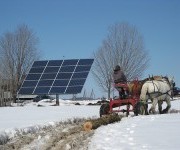Renewable energy could become a standard part of Vermont’s idyllic image.Photo: Sterling CollegeCross-posted from Climate Progress.
Vermont is known for its lush Green Mountains, idyllic farm landscapes, and progressive politics. What many people may not realize is that Vermont has a pretty active secessionist movement too.
Vermont isn’t likely to secede from the U.S. But it is undertaking an ambitious renewable energy program that could at least put it on a path toward “energy secession” — developing a road map for procuring 90 percent of its heat, electricity, and fuels from renewables by 2050.
Under Vermont’s new governor, Peter Shumlin, regulators are developing the state’s first comprehensive energy plan in over a decade. And this one is certainly forward-looking.
Vermont currently gets about 25 percent of its electricity from renewables — mostly biomass and hydro. But officials want to diversify technologies, address underserved markets like heat and fuels, and dramatically improve efficiency in all sectors. The state released its final comprehensive plan for 2011 last week.
Vermont has already embraced a modest transition to renewables, implementing a feed-in tariff in 2009 and developing a renewable energy standard (heat and electricity) of 20 percent by 2017. This latest plan, which just went through an extensive public commenting period, takes these efforts to the next level.
After Vermont received a devastating surprise pummeling from Hurricane Irene in August, state planners have taken the experience to heart, using it as one of the central drivers in the state’s new energy plan.
In the wake of Tropical Storm Irene, the need to align local, regional, and state policies across agencies and departments to support thoughtful and resilient growth in our downtowns and villages has never been more acute. The Agency of Commerce and Community Development, with the support of the Climate Cabinet, will complete a review of the state’s designation programs in 2012.
Prior to Tropical Storm Irene, the state had already set a goal of 5 percent reduction in energy usage across state government. Now that the state faces significant infrastructure repair and rebuilding, energy usage in our state buildings is even more central to our planning. The CEP recommends that the state sharpen its focus on efficient buildings while strategically deploying renewable energy systems.
… We recommend the midcentury goal while recognizing that we must pursue our goals responsibly, ensuring overall energy costs for our businesses and residents remain regionally competitive. But we must also act boldly to protect our environment and our economic security.
Kudos to Vermont for considering such a bold vision for the future and taking a real step toward independence.


